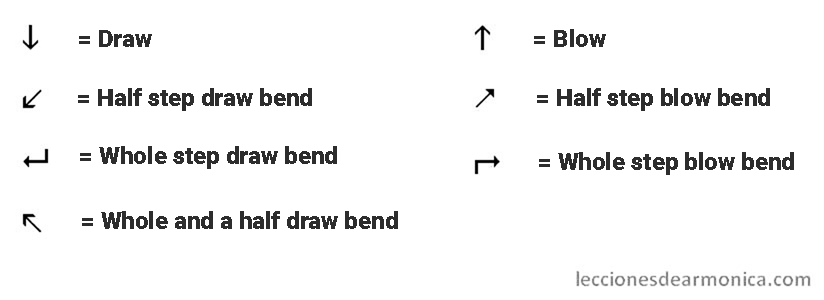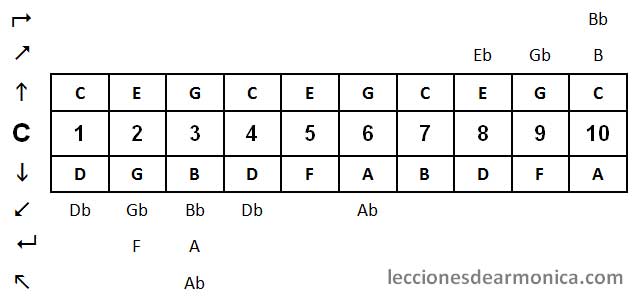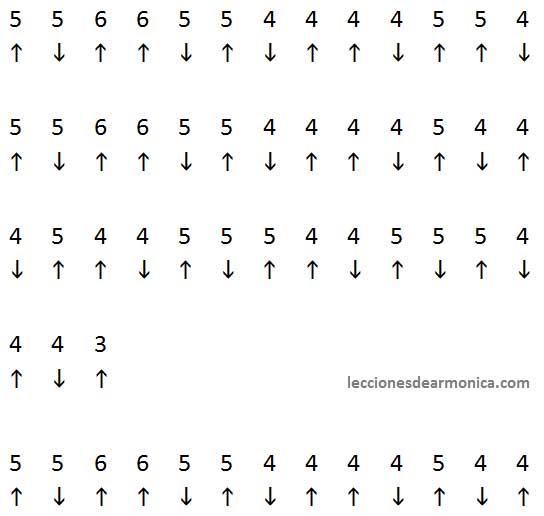In this tutorial you will learn how to read harmonica tabs and especially the one I will use for all songs and exercises.
¿What is a Tab?
A tablature is a simplified form of musical writing for many instruments (not just harmonica) that presents only the positions and locations on the instrument for performing a piece of music, without considering duration of the notes like whole notes, half notes, quarter notes, and the pitch of the notes (C, D, G, etc.).
It is a simple way to present the notes you have to play and it is a lot easier reading method than standard music notation.
This is the main reason it is widely used and especially recommended for beginners. However, a good song performance will depend on your ability to play by ear. The first aim of tablature is to facilitate learning of our instrument, and once you develop a good musical ear, you will not depend on them so much.
To simplify reading, tablature does not include a lot of musical information: rhythm, silences, accents, dynamics, etc., and most harmonica techniques. Therefore, first listen to the song that you want to play and after that try to play it, because having the song by ear will serve you as an important guide to interpret the tablature correctly.
Tabs are specific to each instrument. For example, the tablature for the diatonic harmonica (or blues harmonica) indicates the cell number that we have to play (between cells 1 and 10) and if we have to blow this cell, draw it (inhale it) or bend it.
There are many types of harmonica tablatures, but the three most conventional are:
- using arrows (upwards indicates a blow note and downwards indicates a draw note)
- using brackets for draw notes and only the cell number for the blow notes
- a minus sign for draw notes and only the cell number or a plus symbol for the blow notes.
In these two last types of tablature, normally the “b” letter is placed to a side of the cell number indicates applying a bending note.
For the tablature system using arrows, the types of bending can be represented with a different inclination of the arrows or with short and parallel lines above the arrow. For example, if there are 2 lines on a down arrow, indicates that we have to play a whole step draw bending.
Personally, and as a harmonica teacher for several years, I have seen that students adapt very well to the tablature system with arrows.
Now let’s see the layout with the location of the blow, draw and bend notes on a standard 10 hole major diatonic harmonica tuned in the key of C:
Anglo-Saxon notation: C = Do D = Re E = Mi F = Fa G = Sol A = La B = Si
The “b” to the right indicates a flat note, it’s a semitone (or halftone) lower than the original note. For example: “Eb” is Mi flat (one semitone below than “Mi”) and corresponds to the one semitone blow bending in hole 8.
To write the complete major scale of C (Do, Re, Mi, Fa, Sol, La, Si, Do) with this tab system will look like this:

Finally, we will see as an example for the song “Ode to Joy” (from Beethoven’s 9th Symphony). This song is in the key of C and is played with a harmonica in C (this is called playing in first position or “straight harp”: playing in the same key as the harmonica tuning). The reading is from left to right and from top to bottom.
Listen to this song and other simple songs for harmonica in C, in this article: Easy harmonica songs for beginners.
Free Newsletter
Join thousands of beginners already learning with me. When you sign up, you’ll receive 5 quick tips to improve your sound instantly — practical exercises you can try today.




I really want to learn the harmonica in memory of my dad, who was so good at it. Thank you for all this helpful information! 😊
Welcome Denise and all the best in your new musical journey with the harmonica!
Hola te escribe Patricia desde Colombia, agradezco tú apoyo para los que estamos empezando con La armónica, explicas super bien.
Hola Patricia, muchas gracias por tu comentario, me alegra saber que mis lecciones resultan claras. Saludos!
I have a d key harmonica do you teach how to play those?
Hi Tessa, the harmonica in the key of D is tuned a whole step higher than the C harmonica. Anyway, you can try playing the easy songs for beginners with your harmonica here: https://www.leccionesdearmonica.com/en/blog/8599/easy-harmonica-songs-for-beginners-with-tabs/ Keep in mind that though you may use the tablature, the audios are for a C harmonica, so they will have a lower pitch when compared to your playing. Regards!
I was given a “Mississippi Harmonica Co.” harmonica and it has 20 holes. Can I work with this to learn how to play the harmonica?
Hi Judith, your harmonica is a tremolo type and it wouldn’t be the right one for learning. You will need a 10 hole diatonic harmonica like the Hohner Special 20. Visit my article about the most recommended harmonicas for beginners here: https://www.leccionesdearmonica.com/en/blog/8812/best-harmonica-for-beginners-buying-guide/ Regards!
I really, really want to play the harmonica. Doesn’t quite make sense yet but it will.
Thank you, Dawn French
Great Dawn! I will be here if you need some help. Regards!